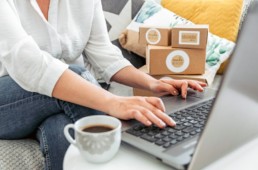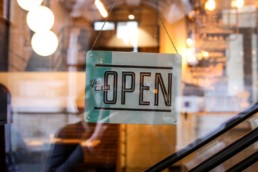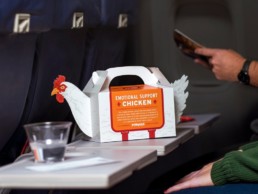4 Need to Know Retail and Packaging Trends for 2021
ecommerce
A lot changed in 2020 but few industries have been as affected as extensively as retail. Make sure you’re keeping up with the changes by staying current and aware of trends. Here are 4 retail and packaging trends to check out for 2021.
1) The importance of standing out in eCommerce

It is now critical to incorporate corrugate into your brand’s online packaging in a way that elevates the experience. Ecommerce shipping design is shifting from regular and plain packaging towards a more functional/stimulating unboxing process for consumers. You can achieve a more sophisticated “luxury corrugate” through thoughtful engineering and art direction, and by personalizing your brand’s shipping packaging.
A personal experience with a salesperson isn’t an option , so the packaging is the true first impression of your brand. Provide your customers a great experience through a shipping package that speaks for itself.
2) Sustainability continues to grow in importance

Aerie Reusable Tote Made From Recycled Material
Consumers are starting to pay more attention to not only what their products and packaging are made of, but also their carbon footprint. Often in the past sustainable options were more expensive but there are a many ways to go about creating sustainable packaging. The concept of “Reduce, Reuse, Recycle” can all be applied in different ways to design an eco-friendly package. Using recyclable materials or creating a reusable design with alternative materials are both ways to incorporate sustainability.
3) Sampler kits are driving huge sales numbers

12 Days of Clean Beauty Kit for Whole Foods Market
60% of customers who receive free samples covert to full-size products. Brands are seeing sales of sampler kits skyrocket compared to previous years. Consumers can no longer test products in store, so giving them the opportunity to test out products from the comfort of their own homes is critical. Sampler kits not only give consumers a chance to find their favorites from your brand, but also provide the excitement of experiencing something new. If your company isn’t offering sampler kits, now is the perfect time to start!
4) Loyalty programs are more important than ever

Your loyalty program can be a deciding factor in whether consumers choose you vs the competitor. Can you say your loyalty program is going above and beyond your customers’ expectations? These programs are an optimal way of thanking the customers who have stuck with you through these trying times. Showing them how important they are to your business is a necessity. A gift incentive, and an unexpected thank you note can go a long way toward building loyalty and creating advocates. VBX Solutions manages multiple loyalty programs and we’re happy to talk to you about how we can take yours to the next level.
What trends or opportunities is your business missing out on? The VBX Solutions team can help you explore your options, and work with you to find the best fit for your brand to drive sales. To learn about these options email us at info@vivaboxsolutions.com
Looking for a solution? We can help.
Headquarters
9211 Corporate Blvd Ste 110
Rockville MD 20850
Satellite Offices
Dallas, TX
Paris, France
San Francisco, CA
Scottsdale, AZ
info@vivaboxsolutions.com
Phone
800-529-1988
Minimum Order Quantities:
RPET Totes: 3,000
Kraft Shoppers: 5,000
Rigid Boxes: 3,000
Folding Cartons: 5,000
O2O: Bridging the Gap for the Online-to-Offline Consumer Experience
ecommerce
As e-commerce becomes more prevalent year-over-year, online and brick & mortar stores (and even DTCs) are scrambling for consumer attention. At the same time, demands for extraordinary experiences grow from both a digital and a physical retail point of view, but from the consumer perspective and certainly from the brand perspective, there is a struggle between the two worlds when it comes to how they work together.
Enter O2O: Online-to-Offline commerce.
O2O is a business strategy designed to bring online customers to brick & mortar locations, as well as create a seamless digital experience before, during, and after their purchases.
Many factors conspired together to create the need for an O2O strategy, but the most important one is that consumers see desktop-mobile-physical shopping and buying as fluid while many companies and brands distinguish them, set attribution targets for each, train and incentivize employees in silos, and make it hard to share data between digital and physical interactions.
The positive spin and the core of O2O strategy? More touchpoints and more opportunities.
Gone are the days of warehouse shelving and big brown boxes stuffed with peanuts and bubble wrap–consumers are driving expectations higher while asking for eco alternatives and at-my-fingertips convenience all at the same time and from every step of the buyer journey.
According to a December 2018 Shopify article, “Every brand wants to capture its market in totality, to reach customers new and old through mediums on-site and off. Today if your company doesn’t have a multi-channel marketing strategy…good luck keeping up.”
This means providing online, brick & mortar, catalog, mobile, and social options in unison. The article also explains that, on average, multi-channel marketing and selling increases revenue by 38%, 120%, 190% with each additional channel respectively.
This kind of growth is considerable and needed in today’s retail climate. However, one area that still gets left unnoticed is how one bridges the online/on-site gap.
Typically, businesses offer consumers choices: they can buy online and have it delivered, or they can go to a store and make a purchase. But what about those who research online and then go to the store to make their purchase? What happens when they order a product and want to pick it up in-store? More so, how do businesses convince consumers to buy online and pick up in store to not only create a more well-rounded shopping experience but to also create their own unique experience and brand-in-hand experience? What is the incentive for consumers to do both?
The answer lies in the conversation that already surrounds O2O. The known benefits of O2O commerce allow businesses to treat online and offline channels as complementary rather than competitive.
- Rapid in-Store pickup of products purchased online
- Online purchase of products while at a physical store (quantity, size, color variations and more vs a lost sale)
- Physical store returns & exchanges for online purchases
- Additional incentives and well-rounded shopping experiences when customers combine online and offline purchases
- A combination of online tracking to offer personalized shopping experiences while consumers are actively shopping
- New opportunities for trial and loyalty program engagement.
Research shows that many customers still want to have shopping experiences that allow them to have tangible interactions with the products they want to buy, but they don’t want to give up their technology.
In a recent study by CBRE Group, discovered that even younger people prefer an in-store, tangible shopping experience. The survey showed that 70% of millennials prefer shopping in stores, even though they spend an average of 7.5 hours a day online. This is one of the top reasons some 22+ beloved “DTC Only” brands have all opened physical spaces beyond temporary pop-ups (including Bonobos, Glossier, Aday, Everlane…and more)
However, despite the need for online and on-site stores to be interchangeable, there is still work to be done, but we are seeing considerable progress with how the two are working together in more efficient, collaborative ways. Nordstrom, Warby Parker, and Allbirds are all examples of companies who have their finger on the pulse of O2O strategy, and they see returns on investment for their efforts. We believe this competitive advantage will only increase over time.
The bottom line is that the buzz around O2O is getting louder, which means e-commerce, retail, packaging, marketing strategies, and on-site touchpoints are essential to address holistically–they can no longer be separated or standalone.
To learn more about how Vivabox can help connect your offline and online experiences using trial & loyalty kits, white label customer care, and more reach out any time! info@vivaboxsolutions.com
Looking for a solution? We can help.
Headquarters
9211 Corporate Blvd Ste 110
Rockville MD 20850
Satellite Offices
Dallas, TX
Paris, France
San Francisco, CA
Scottsdale, AZ
info@vivaboxsolutions.com
Phone
800-529-1988
Minimum Order Quantities:
RPET Totes: 3,000
Kraft Shoppers: 5,000
Rigid Boxes: 3,000
Folding Cartons: 5,000
It’s Not Medieval; It’s a Renaissance: Why Retail Isn’t Dead
ecommerce
We hear it quite a bit these days: online shopping is killing brick and mortar retail. It’s only a matter of time before it runs traditional stores out of business. Malls are drying up, stores we all grew up with are going out of business, and comparison shopping with the swipe of a finger on a digital screen has customers leaving stores without a purchase because they can buy it online, or somewhere else, for less.
As of the last quarter of 2018, e-commerce sales account for just 9.9% of overall retail sales in the US. That means 90.1% of all purchases are still being made in physical stores. The increase in online sales is growing, which creates a digital disruption of brick-and-mortar, but retail is far from dead and buried. To remain competitive in today’s mobile-fueled marketplace, retailers need to pay closer attention to market demand and conform their stores to changing consumer habits. Better yet, set a new standard for shopping and buying.
Despite the gloomy forecasts of retail, consumers still enjoy the instant gratification that comes from buying products in person instead of waiting for delivery (even if it’s only a day or a few hours). They enjoy the experience of shopping–not necessarily the simple act of purchasing. Those are two different emotions and should be catered to separately. They love a clever, or attractive, package that they can hold and inspect which might offer a spark of wonder and intrigue — all before they buy. They love a curated box that speaks to their inner “foodie” or “self-care” opportunity.
They want to explore new products and brands to break out of the same-old experiences they are used to. They want products (and services) that make them feel catered to and special. Even those on tight budgets love a little luxury that comes with experiential, adventurous shopping. They want beautiful environments with lovely smells, soft items to “pet,” and products with a wow factor (for themselves and others).
Moreover, the products consumers buy from retail stores are not just items they may need or want, but these items are also like souvenirs they bring home from the stores they frequent. I have been in eye-catching stores with beautiful set-ups and soft lighting, and I found myself wanting to buy something, even if it is a small item because I wanted to take a piece of that experience home with me.
As long as retailers are differentiating themselves on unique products and more remarkable shopping experiences (including exceptional customer service, BOPIS services, vibrant environments, and corresponding digital channels that pair well with their stores), it is easy to recognize that physical retail isn’t dead at all. The atmosphere is quite robust for stores that listen to consumer demands and think like consumers, not like legacy retailers.
Stop into Hudson Yards in NYC for a view into experimental retail spaces — touchable art, IG-friendly stores (Atelier Cologne), food halls and unique food stops (David Chang’s Fuku), landmark experiences (The Vessel), boutique coffee (Blue Bottle), stores that offer self- or assisted-checkout (Stance, Dirty Lemon), alongside a family-friendly sweets-and-games experience from Snark Park — all as ways to bring stickiness (borrowing from digital here) to an environment. And it’s working. Try not to feel wowed when you walk in.
Apocalyptic retail forecasts are only accurate for companies that continue down the “one-size-fits-all” branding and dull store experiences where products are stacked on shelves to get lost in the clutter. There is significant opportunity to take advantage of the 50% year-over-year growth that still exists in physical retail–it just has to be different than what has been done in the past.
Learn more about how Vivabox can curate exploratory, experiential packaging for your products to meet current consumer demands and offer your company better options and fresh SKUs for growth in the changing retail landscape.
Looking for a solution? We can help.
Headquarters
9211 Corporate Blvd Ste 110
Rockville MD 20850
Satellite Offices
Dallas, TX
Paris, France
San Francisco, CA
Scottsdale, AZ
info@vivaboxsolutions.com
Phone
800-529-1988
Minimum Order Quantities:
RPET Totes: 3,000
Kraft Shoppers: 5,000
Rigid Boxes: 3,000
Folding Cartons: 5,000
5 Retail Trends You Can Actually Activate for 2019
ecommerce
In 2019, the market will be defined by emerging technologies that change the way consumers interact with their favorite brands, a more tangible experience (online and on-site), and the emergence of new types of e-commerce.
Let’s take a look at five important trends that will shape retail in 2019 and forward.
1. Brand as Culture
Millennials’ changing preferences and attitudes regarding corporate responsibility and social consciousness have already impacted how retail brands present and position themselves. The trend has resulted in brands equating their internal culture with their exterior identity. Companies are increasingly engaging consumers outside of traditional shopping parameters and becoming cultural figures.
What ideas can you bring to market if you think of physical intercepts as a cultural representation of the connection you have with your consumers vs “buy it now”
Companies can embrace physical and ideological experiences that immerse customers into a full buyer’s cycle. The days of clever campaigns being enough are pretty much done. Companies will have to consider the image their brand conveys to the world in ethos, all senses, and in packaging (which are blending more than ever).
2. Experiential Retail
The old model of in-store and online retail strictly focused on products being sold. However, consumers have been moving away from strictly shopping for products and are now searching for a more engaging experience. The trend has been primarily driven by millennials and their preference for experiences over things.
Consumers are shopping more with their emotions rather than their wallets. Note, we said shopping. Physically walking into a store should be an escape, a chance to browse, a chance to meander. Buying, on the other hand, is assumed to be pretty quick and easy — a few clicks, done.
Re-designed signage and remodeling a store aren’t enough, both the stores and the brands now realize they can only survive if they create something worth visiting.
For example, stores like Sephora have rethought their retail experiences by combining traditional elements, trial, loyalty programs, and their mobile apps pretty seamlessly. (they’re a client, we’re biased)
Samsung unveiled a $43 million “pop-up” that features its products but doesn’t have any for sale.
The emergence of virtual reality, augmented reality, and improved mobile connectivity have added new layers of experience to add to their retail models.
Packaging for online and on-site stores has also emerged as an essential experiential touchpoint. Gone are the days of brown boxes with packaging tape, bubble wrap, and packing peanuts as “the last mile experience.“
Consumers want their packaging to mean something more. To mean something, actually. Colors, fonts, textures, and materials are all a selling point, as well as its ability to be recycled or repurposed. It’s almost as important as the product it holds.
3. Faster Shipping
E-commerce continues its march toward becoming the most popular purchasing medium. In September 2018 the sector expanded by 11.4%. Today, most major brands have an online presence, and they all offer comparable prices. Even stores like Amazon and Walmart have become largely competitive, so retailers seeking to differentiate themselves have had to find other ways to deliver value.
A current Marketing Charts study found that the amount of time people are willing to wait for free shipping has dropped from 5.5 days in 2012 to 4.5 days on average. Programs like Amazon Prime have made two-day shipping the standard, so cutting down on shipping time is vital for any e-commerce business looking to stay on top.
In-store pick-up, new delivery systems, special access, or making the package worth waiting for are all ways to combat warp speed expectations.
4. Subscription E-Commerce
Today’s buyers are also increasingly seeking shopping/buying that is tailored to their preferences and delivered directly to their doors. These trends have resulted in the emergence of subscription e-commerce, which means businesses curate products and ship them to customers with regularity.
According to a recent report by McKinsey & Company, 15% of online consumers signed up for subscription services in 2017, and that trend is only growing.
That said, marketing and maintaining a subscription base can be expensive for some brands and retailers. This is an area where a well-defined test is a must.
5. Multi-Channel, aka Omnichannel, aka The Way Consumers Shop & Buy Naturally in 2019
Even though many brick-and-mortar stores are closing, they still play a significant role in the purchase process. The difference is that it has transitioned from the primary point of sales to being part of a broader retail strategy. Instead of a single touchpoint for consumers, the growing trend in retail has been to expand how brands use brick-and-mortar to catch leads and convert them.
How can retailers maintain omnichannel active and keep personalization and fulfillment streamlined?
This calls for deep integration across all channels, including websites, marketplaces, social media, and brick-and-mortar. It’s time to get departments really working together, and sharing data, and thinking differently about sales attribution. The consumer is already fluid, but most retailers and brands are less so.
Multi-channel is vital for captivating consumers and keeping them engaged from first impressions to the point of sale. Focusing on providing excellent experiences across channels is the best way to stay vital in the upcoming years. Oh how we love a good CX strategy.
The latest trends in retail are driven by a combination of a changing technological landscape and the shifting preferences of consumers created by millennials. By embracing these trends and preparing for them, retailers can look to 2019 as another favorable opportunity to grow.
Looking for a solution? We can help.
Headquarters
9211 Corporate Blvd Ste 110
Rockville MD 20850
Satellite Offices
Dallas, TX
Paris, France
San Francisco, CA
Scottsdale, AZ
info@vivaboxsolutions.com
Phone
800-529-1988
Minimum Order Quantities:
RPET Totes: 3,000
Kraft Shoppers: 5,000
Rigid Boxes: 3,000
Folding Cartons: 5,000
Know Your Customer: Developing Personas for Packaging Strategy
ecommerce
The key to a successful marketing or branding campaign starts with understanding your target audience, and, a well-defined audience begins with developing buyer personas. In the age of IG and e-commerce, your primary and secondary packaging design should most definitely be part of your CX process and strategy.
A buyer persona is defined as a well-developed character created from customer trends and demands. Most companies attract more than one group of people, so they find it beneficial to develop three-dimensional personalities with names, ages, occupations, certain social statuses, education levels, aesthetic principles, family size, buying trends, and more. Brands interact with people, not cardboard cutouts, so developing these personas are helpful to create a range of insights.
Simply put, developing personas is important, and it is incredible what insights surface when companies take the time to get to know them.
Personas and Packaging
When thinking about brand development and the multiple personas you must nurture, packaging becomes a primary touchpoint. Outside of the actual product, the package is the most tangible branding tool a business has, and these personalities can have a significant impact on your design strategy.
For example, if you’re targeting an older persona, you may want to work with more traditional packaging or play with nostalgic designs that tug at their heartstrings or work with packaging that can be repurposed. You also want to assess your font size and contrast and including smart and obvious ways to open the package for hands that have lost some dexterity.
If you’re going to attract a millennial persona, you may want to develop a more sustainable solution that works with contemporary or forward-looking design and trends. And be sure it has an element of IG-bait.
Packaging the same product in different ways can be a great way to embrace all of your personas without exclusion.
The Power of Personas
Once your business has developed well-rounded personas, what can you do with them? You can do anything! Hopefully, you use them to make every brand decision. Considering that it is the consumer that creates demand, it is essential that all marketing and branding strategies keep all personas in the forefront of every decision.
Consulting personas for insights into what your audience will identify with and what will capture their interest is essential to determining the shape, font, color, textures, and materials you use in your packaging design.
As you develop your packaging for your personas, don’t forget to measure your successes and room for improvement. Analyzing past data and current customer responses is a great way to test if your packaging ideas are meeting consumer standards and how they may be changing. Don’t let your personas get stagnant. They should be an ever-changing point of reference to keep your brand, and packaging, moving forward.
Looking for a solution? We can help.
Headquarters
9211 Corporate Blvd Ste 110
Rockville MD 20850
Satellite Offices
Dallas, TX
Paris, France
San Francisco, CA
Scottsdale, AZ
info@vivaboxsolutions.com
Phone
800-529-1988
Minimum Order Quantities:
RPET Totes: 3,000
Kraft Shoppers: 5,000
Rigid Boxes: 3,000
Folding Cartons: 5,000







